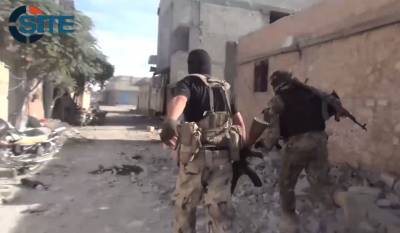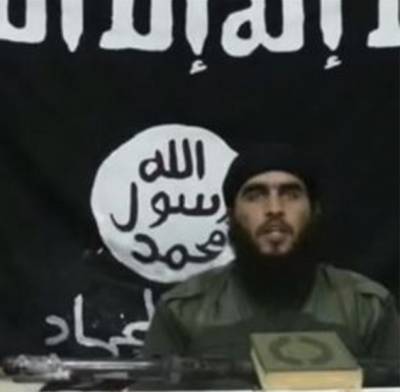Is Syria Falling to Al-Qaeda?

There is a great deal of recent news from Syria, most of it bad. But first, the one bright spot: Kobani, a large city on the border with Turkey that has been under siege by the Islamic State (IS) for several months, has been liberated. A combination of U.S. airstrikes and Kurdish boots on the ground forced IS forces to abandon their attempt to take the city, although not before murdering hundreds (if not thousands) and forcing hundreds of thousands of Syrian Kurds to flee into Turkey.
It is especially important that IS was defeated even though they reinforced their efforts around Kobani and were, apparently, giving the offensive a good deal of effort. The Kurdish forces have continued their advances as well, taking about one-third of the villages surrounding the city. This should encourage those Syrians and Iraqis resisting the group that it is not the invincible force some feared last summer.
 The good news about Kobani is also welcome given two worrisome developments in Syria: advances by the al-Nusra Front, the al-Qaeda (AQ) affiliate in Syria, and the destruction of moderate rebel forces at the hands of the group. Taken together, these developments suggest that, although there are increasingly encouraging signs in Iraq (which I’ll look at next week), the fight in Syria has only begun. They also suggest that the U.S. and allies in the region must do more if we want to see AQ defeated in this critical battlefield.
The good news about Kobani is also welcome given two worrisome developments in Syria: advances by the al-Nusra Front, the al-Qaeda (AQ) affiliate in Syria, and the destruction of moderate rebel forces at the hands of the group. Taken together, these developments suggest that, although there are increasingly encouraging signs in Iraq (which I’ll look at next week), the fight in Syria has only begun. They also suggest that the U.S. and allies in the region must do more if we want to see AQ defeated in this critical battlefield.
As I pointed out in an earlier post, al-Nusra Front has been carrying out a very successful offensive that has taken a great deal of territory in three separate areas of the country. The advances have been against many different combatants involved in the multi-sided conflict in Syria: government, moderate rebels, and IS forces. Since mid-December, the AQ affiliate has attacked and seized regime military checkpoints and bases in Idlib and killed or absorbed an IS-aligned group in that province; seized numerous villages and towns throughout Idlib, Halab, Dara’a, and Qalamoon at the expense of other militant groups and the Syrian government; put the important military air base of Abu al-Dhuhur (on the Hama-Idlib border) under siege; seized a vital government base (Brigade 82) in Dara’a; and overran the strategic town of Shaykh Miskin, which leads directly to Damascus.
The advances are positioning al-Nusra Front to isolate the Alawite strongholds on the coast of Syria and to surround and cut off Damascus from the rest of the country. All this suggests that al-Nusra Front has been able to up its military game significantly in the last few months, probably by convincing other groups to join it through an AQ strategy known as “unifying the ranks.”
 The other aspect of al-Nusra Front advances, especially around Damascus, has been the targeting of any commanders who have sworn an oath of fealty to the IS. This has led to the killing of a number of militants, accused of violating their oaths to al-Nusra Front and defecting to IS, as well as battles with entire groups. Al-Nusra Front killed, for instance, the leadership of a large IS group in Dara’a (the Yarmuk Martyrs Brigade) and expelled the group from the area. The recent formation of the Army of Jihad, consisting of several jihadist groups that have suspected ties to IS, might be one way that al-Nusra Front is dealing with the problem of IS infiltration into the Damascus area. The leaders of the new Army of Jihad have denied any relationship with IS and have been working with al-Nusra Front and its allied groups. It might be that al-Nusra Front views this new organization as a way to keep a closer eye on suspect groups and commanders, while allowing them to contribute to the fight in Syria.
The other aspect of al-Nusra Front advances, especially around Damascus, has been the targeting of any commanders who have sworn an oath of fealty to the IS. This has led to the killing of a number of militants, accused of violating their oaths to al-Nusra Front and defecting to IS, as well as battles with entire groups. Al-Nusra Front killed, for instance, the leadership of a large IS group in Dara’a (the Yarmuk Martyrs Brigade) and expelled the group from the area. The recent formation of the Army of Jihad, consisting of several jihadist groups that have suspected ties to IS, might be one way that al-Nusra Front is dealing with the problem of IS infiltration into the Damascus area. The leaders of the new Army of Jihad have denied any relationship with IS and have been working with al-Nusra Front and its allied groups. It might be that al-Nusra Front views this new organization as a way to keep a closer eye on suspect groups and commanders, while allowing them to contribute to the fight in Syria.
Throughout November and December, al-Nusra Front continued to attack and defeat various nonaligned rebel groups, forcing them to choose either cooperation with AQ or destruction.
One of the casualties of al-Nusra Front’s offensives has been the moderate alliance of rebel forces. The assault on the rebels began three months ago, with an unexpected attack on Harakat al-Hazm (an important group supported by the U.S.) as well as another coalition called the Syria Revolutionaries Front (SRF). As a result, the moderates were expelled from Idlib province and some of them seem to have decided to throw in their lot with AQ. Weapons designed for the moderates have also fallen into al-Nusra Front hands, causing a great deal of anxiety that these could be used against the U.S. or its allies. Throughout November and December, al-Nusra Front continued to attack and defeat various nonaligned rebel groups, forcing them to choose either cooperation with AQ or destruction. By the end of December, it was clear that none of the moderates could act without working with or through al-Nusra Front. The final blow for Harakat al-Hazm may be occurring now, as one of the last remaining pockets of the group is fighting for its existence against a determined assault by the Nusra Front.
The story of the past few months in Syria has thus been one of immense growth in the power and reach of AQ, even while IS has suffered serious setbacks. Thus, although the news from Iraq is generally good, it might be that the U.S. and its allies have been focusing too much attention on one enemy and not enough on another equally dangerous one.
